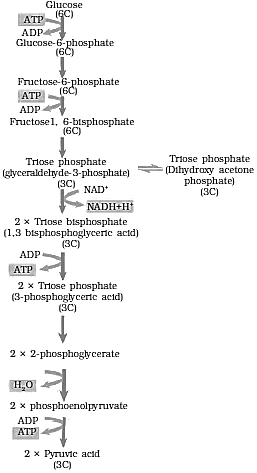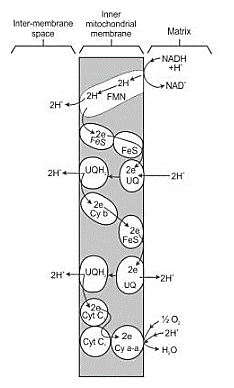*According to the CBSE Syllabus 2023-24, this chapter has been renumbered as Chapter 12.
BYJU’S provides NCERT Solutions for Class 11 Biology Chapter 14 Respiration in Plants in a format that can be downloaded. NCERT solutions are framed by subject experts, and faculty members have extensive knowledge of their streams. They deliver students with answers to all the questions present in the NCERT textbook in the same order according to the latest CBSE guidelines.
Solving from NCERT Solutions enables students to adapt to the answering methodologies adhering to the latest CBSE Syllabus 2023-24 and its guidelines. This prepares Class 11 students to face the final examination with effective management of time as well as learn the skills to answer tactfully in order to score high marks. NCERT Solutions for Class 11 elucidate details of all the chapters covered in the Class 11 NCERT textbook. These serve as resources for all the solutions. Students can hence refer to these solutions without any fear of missing out on important topics or questions.
NCERT Solutions for Class 11 Biology Chapter 14 – Respiration in Plants
Access Answers to NCERT Class 11 Biology Chapter 14 – Respiration in Plants
1. Differentiate between
(a) Respiration and Combustion
(b) Glycolysis and Krebs’ cycle
(c) Aerobic respiration and Fermentation
Solution:
a) Respiration and Combustion
| Respiration | Combustion |
| It is a biochemical process. | It is a physicochemical process. |
| The temperature stays low. | Temperature drastically rises. |
| Occurs in living cells. | It is a non-cellular process. |
| Energy is entrapped in the form of ATP. | ATP is not required for the combustion process. |
b) Glycolysis and Krebs’ cycle
| Glycolysis | Krebs Cycle |
| The first step in respiration. | The second step in respiration. |
| It takes place in the cytoplasm. | It takes place in mitochondria. |
| It occurs both aerobically and anaerobically. | It occurs only in aerobic. |
| Two ATPs are consumed. | ATPs are not consumed. |
| The net gain is 8 ATP’s. | The net gain is 24 ATP’s. |
| It is a linear pathway. | It is a circular pathway. |
c) Aerobic respiration and Fermentation
| Aerobic respiration | Fermentation |
| Included in the exchange of gases. | It does not include the exchange of gases. |
| Oxygen is necessary for aerobic respiration. | Oxygen should be absent for the fermentation process. |
| Respiratory material is completely oxidised. | Respiratory material is incompletely oxidised. |
| The end products are inorganic. | At least one product is organic. |
2. What are respiratory substrates? Name the most common respiratory substrate.
Solution:
Organic substrates that are oxidised during respiration to liberate energy inside the living cells are respiratory substrates. Carbohydrates, proteins, fats and organic acids are the most common respiratory substrate.
3. Give the schematic representation of glycolysis.
Solution:
The schematic representation of glycolysis is as follows:

4. What are the main steps in aerobic respiration? Where does it take place?
Solution:
The main steps in aerobic respiration are as follows:
- Glycolysis: Occurs in the cytoplasm(cytosol), where glucose is broken down to pyruvic acid.
- Oxidative decarboxylation of pyruvic acid to acetyl coenzyme-A: Takes place inside the mitochondrial matrix.
- TCA, or Krebs cycle, takes place in Mitochondrial matrix where pyruvic acid is oxidised to transform the energy contained in these molecules into ATP.
- Electron transport chain occurs in mitochondrial membrane involves ATP synthase complex.
5. Give the schematic representation of an overall view of Krebs’ cycle.
Solution:
The schematic representation of an overall view of Krebs’ cycle is as follows:

6. Explain ETS.
Solution:

- The electron transport system (ETS) is found in the inner mitochondrial membrane and aids in liberating and using the energy stored in the NADH+H+ and FADH2
- NADH+ H+, formed while citric acid cycle and glycolysis occur, is oxidised by NADH dehydrogenase or complex I.
- Electrons hence produced are conveyed to ubiquinone via FMN.
- Similarly, the complex II or FADH2 synthesised during the citric acid cycle is conveyed to ubiquinone.
- From ubiquinone, electrons are accepted by the complex III or cytochrome bc1, which furthermore gets conveyed to cytochrome c, which serves as a mobile carrier between the cytochrome c oxidase complex and complex III comprising of cytochrome a and a3 with copper centres (complex IV) additionally.
- When electrons are transferred from each complex, simultaneously other processes occur, such as production of the ATP from ADP and the inorganic phosphate through the action of ATP synthase (complex V).
- This amount of ATP production is dependent on the molecule that has been oxidised. 3 ATP molecules are generated by the oxidation of 1 molecule of NADH, while 1 FADH2 molecule, upon oxidation, produces 2 ATP molecules.
7. Distinguish between the following:
(a) Aerobic respiration and Anaerobic respiration
(b) Glycolysis and Fermentation
(c) Glycolysis and Citric acid Cycle
Solution:
a) Aerobic respiration and Anaerobic respiration
| Aerobic respiration | Anaerobic respiration |
| Occurs in the presence of Oxygen. | Occurs in the absence of Oxygen. |
| Involves complete breakdown of respiratory materials. | Involves partial breakdown of the gases. |
| Carbon dioxide and water are the end products. | Carbon dioxide and ethanol are the end products. |
| It involves the exchange of gases. | Does not include the exchange of gases. |
b) Glycolysis and Fermentation
| Glycolysis | Fermentation |
| It is the first step in aerobic respiration, and it is common to both aerobic and anaerobic modes of respiration. | It is anaerobic respiration which does not require Oxygen. |
| It produces pyruvic acid. | It produces lactic acid and ethanol. |
| It produces two molecules of NADH for every glucose molecule. | Uses NADH generated during glycolysis. |
| It forms two ATP for every glucose molecule. | It does not produce ATP. |
c) Glycolysis and Citric acid Cycle
| Glycolysis | Citric acid cycle |
| Occurs inside the cytoplasm. | Occurs inside mitochondria. |
| It is a linear pathway. | It is a cyclic pathway. |
| In Glycolysis, glucose is broken down to pyruvate. | The Acetyl group is broken down completely. |
| The net gain is 8 ATP. | The net gain is 24 molecules of ATP. |
8. What are the assumptions made during the calculation of net gain of ATP?
Solution:
Assumptions made during the calculation of the net gain of ATP are as follows:
- NADH generated inside the mitochondria synthesises 3 ATP molecules during its oxidation.
- NADH formed during glycolysis sends its reducing power into mitochondria via the shuttle system.
- During oxidation of FADH2, 2 molecules of ATP are produced inside mitochondria.
- Formation of 3 ATP in the malate-aspartate shuttle (heart, liver and kidney) and 2 ATP in the glycerol phosphate shuttle (muscles and nerve cells).
9. Discuss, “The respiratory pathway is an amphibolic pathway.”
Solution:
Organic substances such as fats, carbohydrates, proteins, etc., liberate energy when they are disintegrated in the respiratory pathway. This phenomena is said to be catabolic in nature. The respiratory process that serves as a catabolic pathway for the respiratory substrates also serves as an anabolic pathway to produce different metabolic products and secondary metabolites. Thus, the respiratory pathway serves as a catabolic and anabolic pathway. Therefore, the respiratory pathway is an amphibolic pathway.
10. Define RQ. What is its value for fats?
Solution:
The ratio of volume of CO2 evolved to the volume of Oxygen consumed in respiration is called respiratory quotient (RQ) or respiratory ratio.

RQ is less than 1 when the respiratory substrate is either fat or protein.

11. What is oxidative phosphorylation?
Solution:
Oxidative phosphorylation is the conversion of ADP into ATP by electron transport system. Phosphorylation takes place in the inner mitochondrial membrane via the ATP synthetase complex when the hydrogen protons pass through it. The energy essential for phosphorylation is derived from the oxidation-reduction phenomena in respiration. Thus, the process is known as oxidative phosphorylation.
12. What is the significance of the step-wise release of energy in respiration?
Solution:
During respiration single molecule of glucose is disintegrated to generate carbon dioxide and water along with the formation of ATP molecules. If the energy gets released at one go, then most of energy will be lost as heat. In order to synthesise new compounds, the cell should be able to utilise the energy. Hence, the step-wise release of energy in respiration is most efficient in the conservation of energy.
NCERT Solutions for Class 11 Biology Chapter 14 – Respiration in Plants
NCERT Solutions for Class 11 Biology Chapter 14 – Respiration in Plants are classified under Unit 4 – Plant Physiology in the CBSE Syllabus 2023-24. It forms an important part of the unit. This unit contributes to nearly 25% of the total marks, which is around 18 marks majorly. This data is collated from past trends to give an idea as to how important the topic is. The information covered in this unit is significant enough to appear in the entrance examinations. It is a valuable resource from which students can grasp maximum information and has been answered precisely and accurately.
The different types of questions that appear in the board examination are as follows:
- Knowledge-based
- Application-based
- High-order thinking skills
- Remembering
List of subtopics covered in Chapter 14 – Respiration in Plants
| Number | Subtopic |
| 14.1 | Do Plants Breathe? |
| 14.2 | Glycolysis |
| 14.3 | Fermentation |
| 14.4 | Aerobic Respiration |
| 14.5 | The Respiratory Balance Sheet |
| 14.6 | Amphibolic Pathway |
| 14.7 | Respiratory Quotient |
NCERT Solutions for Class 11 Biology Chapter 14 – Respiration in Plants
Respiration is one of the fundamental processes that is carried out by living entities. All the energy that is required for life processes is obtained by the oxidation of some macromolecules derived from food. Autotrophs can synthesise their food through the process of photosynthesis, wherein light energy is trapped and converted into chemical energy. Green plants, different tissues, and non-green cells require food for oxidation. Therefore, food can be translocated to all the non-green parts. Since animals are heterotrophic, they derive their nutritional requirements from plants.
The chapter deals with cellular respiration. It is the mechanism of the disintegration of food materials inside the cell to release energy. This energy is trapped to synthesise ATP, which is the energy currency of a cell.
Key Features of NCERT Solutions for Class 11 Biology Chapter 14 – Respiration in Plants
- NCERT Solutions are framed in accordance with the textbook data.
- Provide answers to all the questions appearing in the same order as provided in the textbook.
- They are the ultimate resources for all academic requirements of students in the CBSE session.
- Solutions are provided in the most efficient and effective pattern.
- The conceptual knowledge of students can be assessed while referring.
- Easily available in a ready-to-download format.
Frequently Asked Questions on NCERT Solutions for Class 11 Biology Chapter 14
What concepts can I learn from the NCERT Solutions for Class 11 Biology Chapter 14?
14.1 – Do Plants Breathe?
14.2 – Glycolysis
14.3 – Fermentation
14.4 – Aerobic Respiration
14.5 – The Respiratory Balance Sheet
14.6 – Amphibolic Pathway
14.7 – Respiratory Quotient








Comments